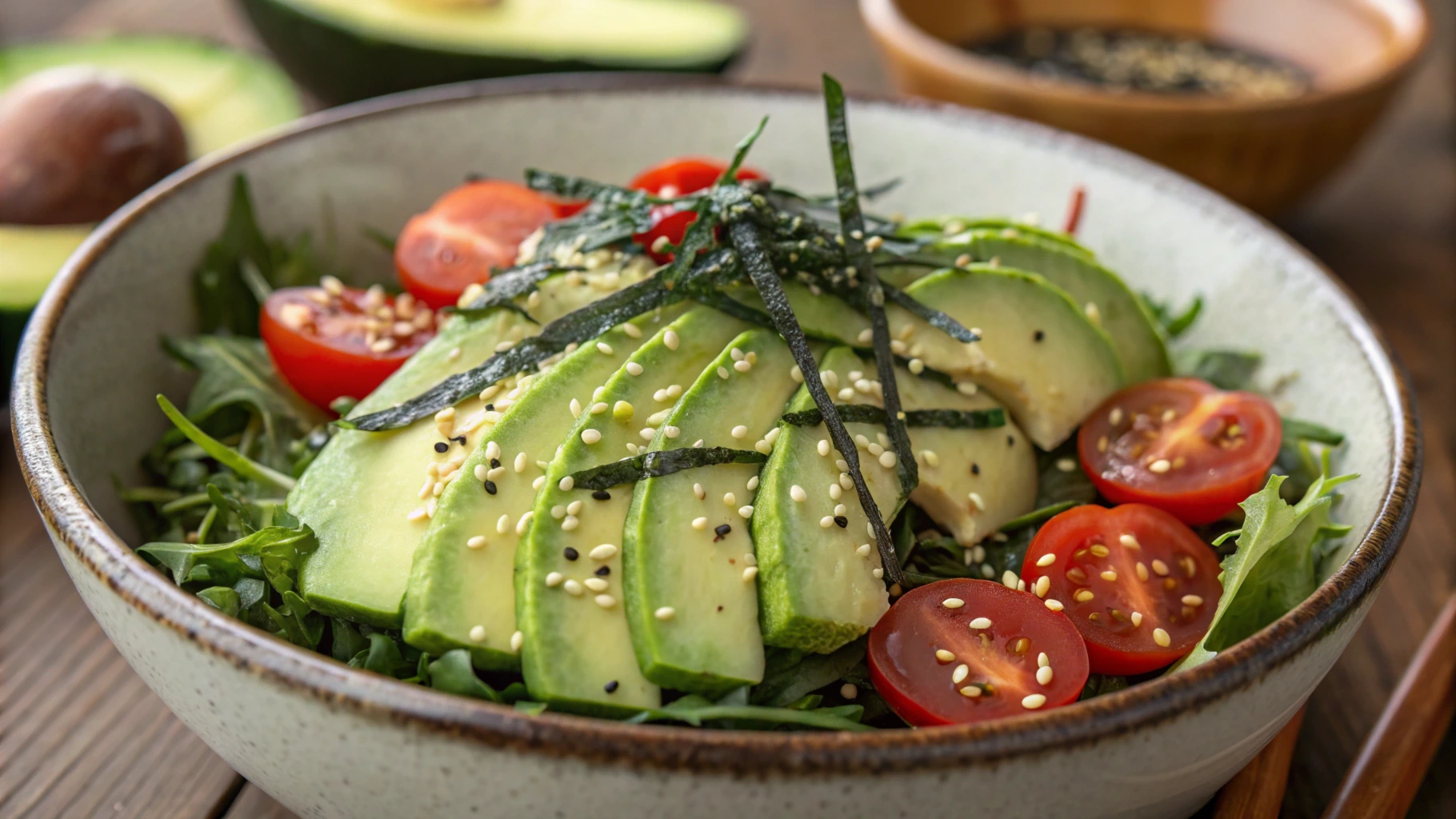Avocado salad Japanese has emerged as a popular dish in modern Japanese cuisine. Combining the creamy texture of ripe avocados with fresh, crisp vegetables and savory dressings, this salad has gained international attention for its health benefits and delightful flavor profile. This dish is not only a testament to Japan’s growing culinary diversity but also reflects the seamless blending of traditional Japanese ingredients with globally loved foods. In this article, we’ll explore everything you need to know about avocado salad Japanese, including its history, ingredients, health benefits, and how to make it at home.
What is Avocado Salad Japanese?
Avocado salad Japanese is a fresh, vibrant dish that highlights the creamy richness of avocado paired with a variety of vegetables, herbs, and flavorful dressings. Unlike traditional Western-style avocado salads, which often feature ingredients like tomato and lettuce, the Japanese version typically includes a range of Japanese ingredients like soy sauce, miso, and sometimes fish or tofu. The result is a uniquely Japanese take on a salad that balances texture and flavor in a way that has captured the attention of food lovers worldwide. While the salad itself can vary, it usually offers a delightful combination of fresh, seasonal vegetables and creamy avocado, making it both nutritious and delicious.
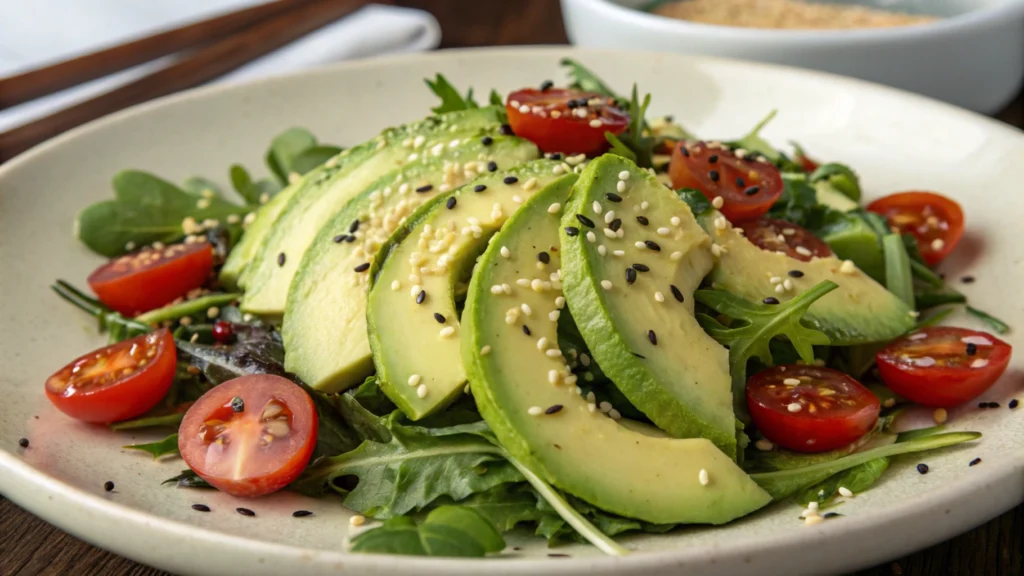
Brief History of Avocado in Japanese Cuisine
Although avocados are not native to Japan, their popularity has surged in recent decades. The avocado’s smooth texture and healthy fat content made it a natural fit for the Japanese diet, which is known for its emphasis on fresh, seasonal ingredients and balanced nutrition. Initially introduced in Japan in the 1990s, avocado was seen as a foreign ingredient, largely associated with Western or Mexican dishes. However, over time, Japanese chefs began experimenting with incorporating avocado into traditional recipes, resulting in dishes like avocado sushi rolls and avocado salad Japanese. Today, avocados are a common ingredient in Japanese restaurants and homes alike, often paired with dishes that highlight the flavors of soy, miso, and fish.
Ingredients in Avocado Salad Japanese
Fresh Avocados
The key ingredient in any avocado salad Japanese is, of course, the avocado itself. Known for its creamy texture and mild flavor, avocados add a richness to the salad that complements the other ingredients. The high-fat content in avocados is largely made up of monounsaturated fats, which are considered heart-healthy. This makes avocados a nutritious addition to the Japanese salad, providing a satisfying texture that pairs well with the crispy vegetables and savory dressing.
Vegetables Commonly Used
In avocado salad Japanese, fresh vegetables play a significant role in providing balance to the creamy avocado. Common vegetables used in this dish include:
- Cucumber: Its refreshing crunch adds contrast to the smoothness of the avocado.
- Radish: Thinly sliced radishes contribute a slightly spicy flavor that balances the richness of the avocado.
- Shiso leaves: These aromatic leaves add a burst of herbal flavor that is distinctly Japanese.
- Carrots: Shredded or julienned carrots offer sweetness and color to the salad.
These vegetables, along with others like bell peppers or cabbage, provide texture and freshness to the dish, making it both satisfying and nutritious.
Dressing Options (Soy Sauce, Miso)
The dressing is an essential component of any avocado salad Japanese, as it brings all the ingredients together with a savory punch. Two of the most popular dressing options are soy sauce and miso-based dressings. Soy sauce adds a salty, umami-rich depth to the salad, while miso offers a slightly sweet and fermented flavor. These dressings are often complemented with ingredients like rice vinegar, sesame oil, and a touch of honey or mirin to balance the flavors. The dressing choices vary depending on regional preferences and personal taste, but both options pair wonderfully with the creamy avocado and fresh vegetables.
Health Benefits of Avocado
Rich in Healthy Fats
One of the primary health benefits of avocado salad Japanese is the inclusion of avocados, which are rich in healthy monounsaturated fats. These fats help to reduce bad cholesterol levels in the body, promoting heart health. Unlike saturated fats, monounsaturated fats are known to support a balanced diet and contribute to overall wellness. Adding avocado to a salad provides a source of good fats, making this dish a healthy choice for those looking to maintain a balanced and nutritious diet.
High in Fiber
Avocados are also an excellent source of fiber, which is essential for digestive health. A single avocado can provide up to 10 grams of fiber, which helps regulate bowel movements and supports a healthy gut. Fiber is also known to help stabilize blood sugar levels, making avocado salad an ideal option for people looking to maintain stable energy levels throughout the day.
Vitamins and Minerals
In addition to healthy fats and fiber, avocados are packed with vitamins and minerals that are essential for overall health. These include:
- Vitamin K: Important for bone health and blood clotting.
- Vitamin C: An antioxidant that supports the immune system and skin health.
- Potassium: Helps regulate blood pressure and maintain proper muscle function.
- Folate: Important for cell function and tissue growth.
Including avocados in avocado salad Japanese offers a nutritious boost, ensuring you’re getting a wide range of essential nutrients.
How to Choose the Right Avocados
Identifying Ripe Avocados
When selecting avocados for avocado salad Japanese, it’s essential to choose ripe avocados. A ripe avocado should yield gently to pressure when squeezed but should not feel mushy. To check for ripeness, press gently on the skin with your fingers. If the avocado gives slightly but doesn’t feel too soft, it’s ready to eat. Avoid avocados with large indentations or dark, mushy spots, as they may be overripe.
How to Store Avocados for Optimal Freshness
If you’re not using your avocados right away, proper storage is key to preserving their freshness. Unripe avocados should be stored at room temperature until they ripen. Once ripe, you can store them in the refrigerator to extend their shelf life. To prevent browning, consider storing cut avocados in an airtight container with a bit of lemon or lime juice to preserve their vibrant green color.
Step-by-Step Guide to Making Avocado Salad Japanese
Preparing the Vegetables
The first step in making avocado salad Japanese is preparing the vegetables. Wash and peel vegetables like cucumber, carrots, and radishes. Slice them thinly or julienne them for a delicate texture. Shiso leaves, if using, should be washed and chopped into small pieces. Be sure to remove any seeds from cucumbers if you prefer a less watery salad.
Cutting and Prepping Avocados
Once the vegetables are prepared, it’s time to cut the avocados. First, slice the avocado in half and remove the pit. Then, carefully scoop the flesh out with a spoon and slice it into cubes or wedges, depending on your preference. Be sure to handle the avocado gently to avoid mashing it.
Mixing the Ingredients
After the vegetables and avocados are prepared, it’s time to mix everything together. In a large bowl, combine the sliced vegetables and avocado. Drizzle the dressing over the top and gently toss to combine. Be careful not to over-mix, as the avocado may become mushy. Taste the salad and adjust the seasoning with more soy sauce, miso, or sesame oil if needed.
Popular Variations of Avocado Salad in Japan
Avocado with Tofu
One popular variation of avocado salad Japanese is to include tofu, a staple ingredient in Japanese cuisine. Soft, silken tofu pairs wonderfully with creamy avocado, creating a satisfying, protein-packed dish. The tofu can be cubed and mixed with the avocado and vegetables, or served on the side as an additional source of texture and flavor.
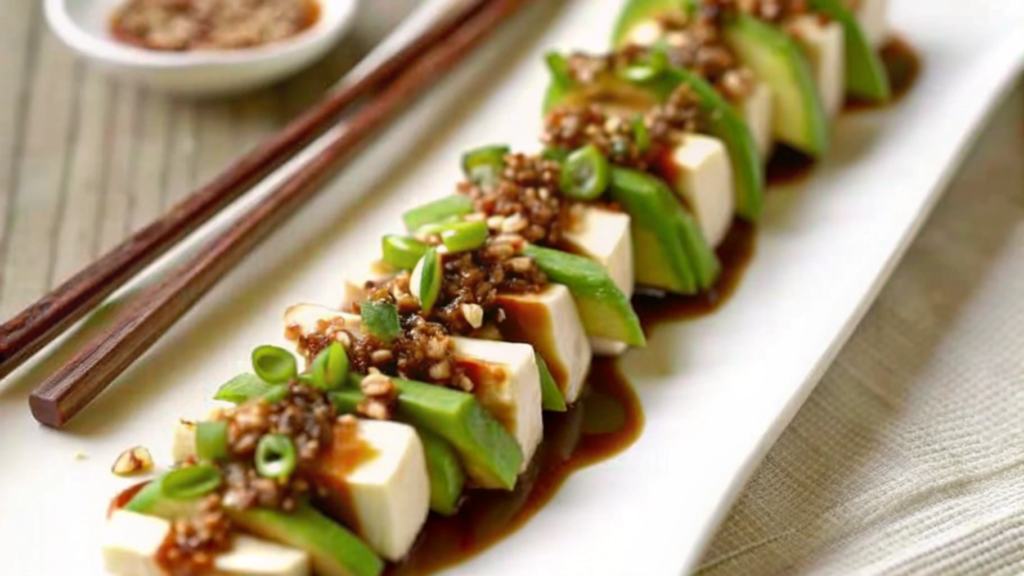
Avocado with Seaweed and Fish
Another popular variation features seaweed and fish, such as tuna or salmon. Seaweed adds an umami-rich flavor that complements the mild avocado, while fish provides protein and additional texture. This variation often features a tangy soy-based dressing and is a great option for those who enjoy the flavors of sushi.
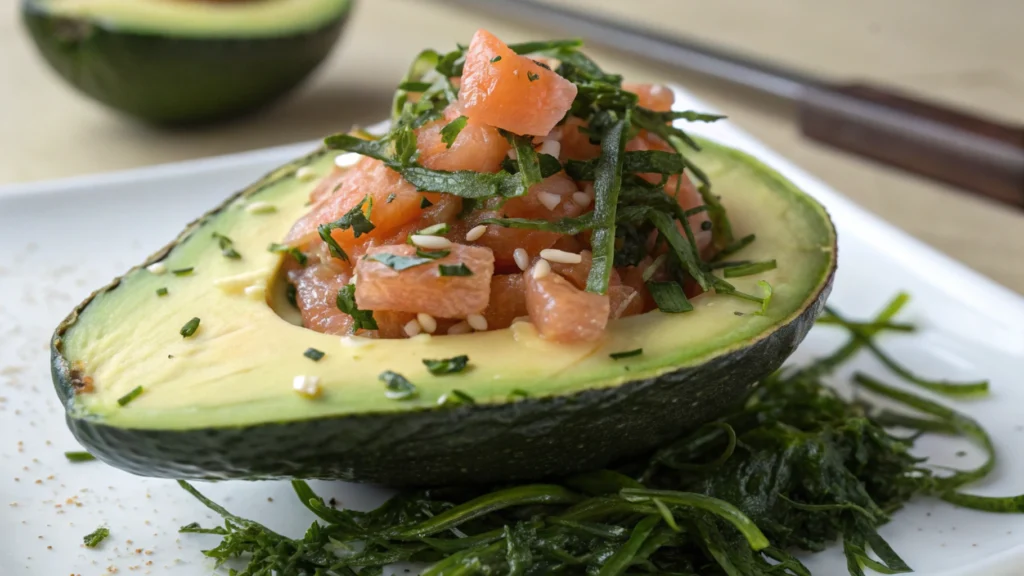
Sushi Rolls Avocado
Avocado has also found its way into sushi rolls, particularly those that focus on raw fish. Avocado adds a creamy element to the roll, balancing the fish’s flavor and creating a delightful contrast in texture. This variation of avocado salad is often served alongside sushi as an appetizer or side dish.
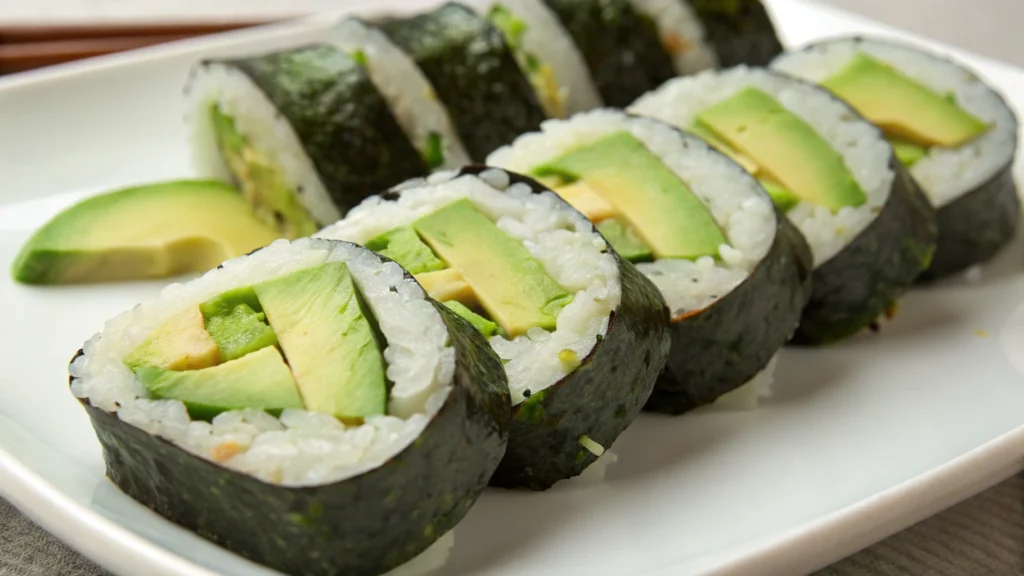
Pairing Avocado Salad Japanese with Other Dishes
Complementary Japanese Side Dishes
Avocado salad Japanese pairs well with a variety of Japanese side dishes. Some excellent choices include:
- Miso soup: A warm, umami-rich soup that complements the freshness of the salad.
- Edamame: Steamed young soybeans lightly salted, providing a simple, protein-packed side.
- Pickled vegetables: The tanginess of pickled vegetables balances the richness of the avocado.
Best Main Courses to Enjoy with Avocado Salad
For a complete meal, avocado salad Japanese pairs beautifully with main courses like:
- Grilled fish: Salmon or mackerel with a simple soy glaze.
- Chicken teriyaki: The savory-sweet flavor of teriyaki chicken complements the creamy avocado.
- Rice bowls: A donburi with vegetables, eggs, or protein can serve as a hearty main course.
Cultural Influence of Avocados in Japan
The Rise of Avocado in Modern Japanese Cuisine
In recent years, avocados have become increasingly popular in Japan, particularly among younger generations. As global food trends have become more influential, avocados have found their way into Japanese menus, becoming a symbol of modern Japanese fusion cuisine. Avocados are now commonly used in sushi, salads, and even as a topping for rice dishes, showing how Japan has embraced this versatile fruit.
Influence of Western Cuisine on Japan
The rise of avocado in Japan reflects the broader influence of Western cuisine on Japanese food culture. As Japanese food evolves and incorporates new ingredients, dishes like avocado salad Japanese have become more commonplace. The fusion of Western ingredients with traditional Japanese flavors is an exciting trend in the culinary world, reflecting Japan’s openness to innovation and creativity.
Flavor Profile of Avocado Salad Japanese
One of the most appealing aspects of avocado salad Japanese is its umami-rich flavor profile. The combination of avocado’s creamy texture, soy sauce’s saltiness, and miso’s depth creates a savory, satisfying taste that is distinctly Japanese. This umami base is balanced by the freshness of the vegetables, creating a harmonious flavor experience.
Balancing Creamy Avocado with Tangy, Savory Ingredients
The creamy texture of avocado contrasts beautifully with the tangy, savory elements of the salad. Soy sauce, miso, and rice vinegar add a layer of complexity to the dish, while fresh vegetables like cucumber and radish offer a crisp, refreshing bite. The balance of flavors and textures is key to the success of this dish, making avocado salad Japanese a flavorful and satisfying option for any meal.
Tips for Enhancing Your Avocado Salad Japanese
Adding Crunch with Toppings
To elevate the texture of your avocado salad Japanese, adding crunchy toppings is a great way to introduce contrast. Toppings like toasted sesame seeds, crispy fried onions, or even crushed nuts (such as almonds or cashews) provide an added crunch that complements the creamy avocado. Additionally, adding crispy tempura bits or even a sprinkle of roasted seaweed can enhance the overall texture of the salad, giving it more depth and bite. These crunchy elements not only improve the salad’s texture but also bring a new flavor dimension that balances the softness of the avocado and vegetables.
Using Citrus to Brighten the Dish
Citrus fruits, like lemon or lime, can work wonders in brightening up your avocado salad Japanese. A squeeze of fresh citrus juice adds a zesty tang that cuts through the richness of the avocado and complements the savory dressing. The acidity of the citrus also helps balance the flavors, making the salad more refreshing and vibrant. You can even use citrus zest to sprinkle over the salad for an additional burst of flavor, enhancing the dish’s overall appeal.
Experimenting with Flavors
One of the best things about avocado salad Japanese is its versatility. You can experiment with a variety of flavors to customize the salad to your taste. For example, try adding a touch of wasabi to the dressing for a spicy kick or a drizzle of honey to create a balance between sweet and savory. You can also incorporate pickled vegetables like umeboshi (pickled plum) or even spicy miso for a bolder flavor. The beauty of this salad is that it can be tailored to suit your preferences, so don’t hesitate to try different seasonings and flavors.
How to Serve Avocado Salad Japanese
Best Ways to Present the Salad
Presentation is key when serving avocado salad Japanese. To create an aesthetically pleasing dish, consider serving the salad in small individual bowls or on a platter, garnished with additional toppings like sesame seeds, shiso leaves, or a few slices of radish for extra color. The contrast of the creamy green avocado with the vibrant vegetables creates a visually appealing dish. You can also drizzle the dressing over the salad just before serving to ensure that the ingredients remain fresh and the dressing doesn’t wilt the vegetables. For an elegant touch, serve the salad with a side of crispy tempura or sushi rolls.
Serving Sizes and Occasions
Avocado salad Japanese is a versatile dish that can be served in various sizes depending on the occasion. For a light appetizer, a small individual portion is perfect. However, for a main dish or as part of a larger meal, you can serve it in a bigger bowl to accommodate more guests. This salad is great for lunch, dinner, or as a side dish for special occasions like family gatherings, potlucks, or even a sushi night at home. It’s also an excellent choice for outdoor events like barbecues or picnics because it can be made ahead of time and served cold.
Avocado Salad Japanese as a Healthy Meal Option
Low-Carb and Nutritious
Avocado salad Japanese is a low-carb, highly nutritious option, making it a great addition to any healthy meal plan. The avocado provides healthy fats that are essential for heart health, while the fresh vegetables offer a variety of vitamins and minerals. This salad is a great choice for those following a ketogenic or low-carb diet, as it is rich in healthy fats and fiber, without the added carbohydrates from grains or starchy vegetables. It’s a perfect meal for anyone looking to maintain a balanced, nutrient-dense diet.
Vegetarian and Vegan-Friendly
This salad is naturally vegetarian and vegan-friendly, making it an excellent choice for those following plant-based diets. By focusing on fresh vegetables, tofu, and avocado, avocado salad Japanese provides plenty of plant-based protein and fiber, helping to keep you full and satisfied. For a heartier vegan option, you can also add edamame or tempeh to increase protein content. With the use of miso, soy sauce, and sesame oil in the dressing, the salad also stays entirely vegan, offering a flavorful and satisfying meal.
Perfect for Weight Loss
Avocado salad Japanese is a great option for anyone looking to lose or maintain weight. The healthy fats from the avocado help to keep you feeling fuller for longer, reducing the likelihood of overeating. Additionally, the vegetables in the salad are low in calories but high in fiber, which promotes digestion and supports healthy weight management. Since this salad is both nutritious and filling, it can help curb cravings and make you feel satisfied without consuming excessive calories, making it an excellent choice for anyone aiming for a balanced, weight-conscious diet.
Pairing Drinks with Avocado Salad Japanese
Best Beverages to Complement the Dish
When it comes to pairing beverages with avocado salad Japanese, there are a variety of options that complement the fresh, savory flavors of the dish. For a non-alcoholic option, green tea or jasmine tea are perfect because they provide a light, refreshing balance to the richness of the avocado. The subtle flavors of the tea won’t overwhelm the salad, allowing the dish’s umami flavors to shine.
For those who prefer something a little stronger, a light white wine such as a Sauvignon Blanc or Pinot Grigio pairs beautifully with this salad. The crisp acidity of these wines helps to cut through the creamy avocado and savory dressing. If you prefer a cocktail, a gin and tonic with a twist of lime could also be a refreshing option to pair with the dish, offering a crisp and citrusy contrast to the richness of the salad.
Storage Tips for Leftover Avocado Salad
How to Store Leftover Salad
If you have leftover avocado salad Japanese, storing it properly will help maintain its freshness for as long as possible. To store leftovers, place the salad in an airtight container and refrigerate it. While the salad is best when freshly made, it can last for up to a day or two in the fridge. To keep the ingredients from wilting, try to store the dressing separately and toss it just before serving.
Best Ways to Prevent Browning of Avocados
One of the challenges with storing avocado salad Japanese is preventing the avocado from browning. To avoid this, consider adding a little lemon or lime juice to the avocado before mixing it into the salad. The acidity from the citrus helps slow down the oxidation process. Another effective method is to place plastic wrap directly on the surface of the salad to reduce exposure to air. You can also store the avocado pit in the salad container to help minimize browning. While these tips can help preserve the freshness of the avocado, it’s best to consume the salad within a day or two to enjoy the best texture and flavor.
FAQs
Is avocado salad good for you?
Yes, avocado salad is beneficial for you. It is rich in healthy fats, fiber, and various vitamins and minerals, including potassium and vitamin E. These nutrients contribute to heart health, improve digestion, and support overall well-being.
Do Japanese eat avocado in sushi?
Yes, Japanese do eat avocado in sushi, though it is more commonly found in modern or fusion sushi. Avocado adds a creamy texture and mild flavor that complements other ingredients, especially in rolls like California rolls.
How to have avocado for dinner?
To have avocado for dinner, you can use it in a variety of ways. For example, you can add slices to a salad, mix it into a grain bowl, or spread it on toast. Additionally, you can make avocado-based dishes like guacamole or avocado pasta for a satisfying meal.
How do you cut an avocado for salad?
To cut an avocado for a salad, start by slicing it in half lengthwise around the pit. Twist the halves to separate them, and remove the pit using a spoon or knife. Then, scoop out the flesh and slice or cube it as desired, ready to add to your salad.
Conclusion
Avocado salad Japanese is a healthy, flavorful dish that can easily be customized to suit your preferences. By enhancing the salad with crunchy toppings, bright citrus, and unique flavors, you can create a delicious meal that pleases the palate. Whether served as a light lunch or a side dish, this salad is versatile, nutritious, and perfect for various dietary needs, including vegan and low-carb diets. With the right drink pairings and storage tips, you can enjoy your avocado salad Japanese fresh and tasty for any occasion.
If you enjoy experimenting with flavors, explore these other Tasty Cook recipes:

